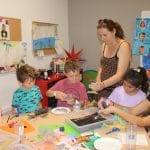Are you looking for ways to speak Spanish with your family? It’s typical to depend on school to help our children to improve their language skills if you’re not a confident speaker but you can make a big difference with just a few small steps. We’re here to give you some handy tips for kids to learn Spanish outside the classroom and on how to incorporate Spanish into your daily life.
 Make it fun
Make it fun
Kids spend a lot of time at school learning grammar and studying from textbooks, so make Spanish outside of school fun and interactive. You want your kids to enjoy learning Spanish and the best way to do this is through fun activities. Why not do a treasure hunt for kids in Spanish so they can associate the vocabulary with the object and they win a prize at the end for doing such a great job!
 Get one-to-one contact with a native Spanish speaker
Get one-to-one contact with a native Spanish speaker
Where possible, involve a native Spanish speaker in your family’s activities so that they pick up on colloquial phrases and have someone to correct their mistakes in a natural way. Taking Spanish classes specifically designed for children that are fun and really work on your child’s creative interests is a great way to make Spanish into something they are able to do from home at a time that will suit you and your child’s timetable. You can take Spanish classes online too so your child can have a quick conversation class while having breakfast!
 Short online classes for kids will add some structure to their learning and will provide an experienced professional who can point them in the right direction. This is a great alternative if you don’t live in a Spanish speaking country.
Short online classes for kids will add some structure to their learning and will provide an experienced professional who can point them in the right direction. This is a great alternative if you don’t live in a Spanish speaking country.
If you’re in a Spanish-speaking country, you can also arrange to get a native Spanish guide or au-pair to really help maximise Spanish being used and spoken around your children.
 Cooking in Spanish
Cooking in Spanish
Look for a recipe in Spanish on the Internet (there are plenty of great cooking websites and we in LAE Kids have quite a few on our Facebook page). Make a shopping list in Spanish and take the kids to buy the ingredients – a smaller market makes this experience more interactive as they can see the produce. The key is to have them recognise the words and the objects together, like they would in their native language. Then following the Spanish recipe, get the kids involved in the cooking. We often use this method in our Spanish classes in Madrid and kids love it!
 Cinema in Spanish
Cinema in Spanish
Nowadays it’s become more common to find movies in Original version in cinemas. If there are no such options in your home country, Netflix offers a great alternative. Pick a film that’s sure to be a hit with the kids and they probably won’t even notice it’s in Spanish!
 Post-it notes
Post-it notes
Help your kids to learn vocabulary around the house by putting post-it notes on different objects e.g. fridge, table, washing machine. After the kids have learnt the vocabulary you can test them by doing a race. Give each kid a set of post-it notes with objects on, they have to run around the room and put them in the correct place in the shortest time possible. Alternatively, you can do a relay race and the kids have to work together to place the post-it notes in the quickest time possible.
 Arts and crafts
Arts and crafts
This can be enjoyed by all the family together. Have a look on the Internet for some great craft ideas in Spanish, buy the materials and get making. You may need to pre-teach the kids (and yourself!) arts and crafts vocabulary for the materials and verbs (e.g. cut, stick, glue).
 Read in Spanish
Read in Spanish
Reading in Spanish is a great way to improve fluency. But instead of reading from boring textbooks pick something your kids really enjoy. It doesn’t matter if they and you don’t understand all of the words but you’ll gradually get the gist of the book. For younger kids pick really visual books or perhaps classic stories that they already know and understand in their native language. Depending on your level of Spanish you can ask them simple questions about the pictures (e.g. Where is the cat? How many stars are there) to help them interact.
 Leave the grammar in the classroom
Leave the grammar in the classroom
Don’t put too much energy and focus on grammar at home, leave that for the classroom at school or here at LAE Kids where we know all the methodology to make it enjoyable for them. Relax while implementing all these tips speaking Spanish and the grammar will come naturally.
These are our top tips for kids to learn Spanish outside the classroom. Have you tried some of these? Share your experience with us on our Facebook and let us know which one is your favorite!



